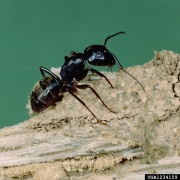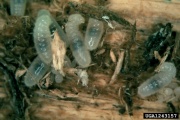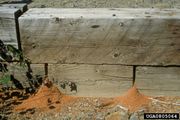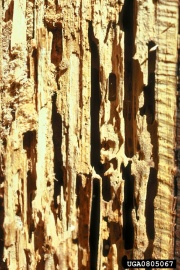Difference between revisions of "Carpenter ant"
Jump to navigation
Jump to search
| (4 intermediate revisions by the same user not shown) | |||
| Line 1: | Line 1: | ||
| − | [[File:Blk.Carpenter_ant_forestryimages.org.jpg|thumb| | + | [[File:Blk.Carpenter_ant_forestryimages.org.jpg|thumb|Back carpenter ant]] |
== Description == | == Description == | ||
| − | + | [[File:Blk.Carpenter_ant_larvae_forestryimages.org.jpg|thumb|Carpenter ant larvae]] | |
Large, black wood-nesting ant of the genus Camponotus that is native to North America. Carpenter ants hollow out nest areas in old logs, dead trees, and wooden structures. These black ants are about 1 cm in length. They prefer to nest in moist areas and can severly damage any type of wood. Their frass looks like coarse sawdust and often contans dead ants and insect parts. Their bites can be painful when formic acid is injected. The two most common carpenter ant species are: | Large, black wood-nesting ant of the genus Camponotus that is native to North America. Carpenter ants hollow out nest areas in old logs, dead trees, and wooden structures. These black ants are about 1 cm in length. They prefer to nest in moist areas and can severly damage any type of wood. Their frass looks like coarse sawdust and often contans dead ants and insect parts. Their bites can be painful when formic acid is injected. The two most common carpenter ant species are: | ||
* ''Camponotus pennsylvanicus'': Eastern US, black with yellowish hairs | * ''Camponotus pennsylvanicus'': Eastern US, black with yellowish hairs | ||
* ''Camponotus modoc'': Western US, black with reddish legs | * ''Camponotus modoc'': Western US, black with reddish legs | ||
| + | [[File:Blk.Carpenter_ant_frass_forestryimages.org.jpg|thumb|Carpenter ant frass]] | ||
| + | [[File:Blk.Carpenter_ant_damage_forestryimages.org.jpg|thumb|Carpenter ant damage]] | ||
| − | |||
== Synonyms and Related Terms == | == Synonyms and Related Terms == | ||
| Line 20: | Line 21: | ||
* Thorax: no spines | * Thorax: no spines | ||
| − | == | + | ==Resources and Citations== |
| − | |||
| − | |||
| − | |||
| − | |||
| − | |||
| − | + | * MuseumPest.net at [https://museumpests.net/ Link] | |
* Eric H. Smith, Richard C. Whitman, ''NPMA Field Guide to Sturctural Pests'', National Pest Management Association, Fairfax VA, 2005. | * Eric H. Smith, Richard C. Whitman, ''NPMA Field Guide to Sturctural Pests'', National Pest Management Association, Fairfax VA, 2005. | ||
Latest revision as of 15:08, 20 May 2022
Description
Large, black wood-nesting ant of the genus Camponotus that is native to North America. Carpenter ants hollow out nest areas in old logs, dead trees, and wooden structures. These black ants are about 1 cm in length. They prefer to nest in moist areas and can severly damage any type of wood. Their frass looks like coarse sawdust and often contans dead ants and insect parts. Their bites can be painful when formic acid is injected. The two most common carpenter ant species are:
- Camponotus pennsylvanicus: Eastern US, black with yellowish hairs
- Camponotus modoc: Western US, black with reddish legs
Synonyms and Related Terms
carpenter ants (pl.); Camponotus spp.;
Physical and Chemical Properties
- Workers: 3.5-13 mm; may emit strong formic acid odor
- Queens: 13-17 mm
- Color: most commonly black but may be combinations of red, brown, and black
- Antenna: 12-segmented, no club
- Thorax: no spines
Resources and Citations
- MuseumPest.net at Link
- Eric H. Smith, Richard C. Whitman, NPMA Field Guide to Sturctural Pests, National Pest Management Association, Fairfax VA, 2005.
- The American Heritage Dictionary or Encarta, via Microsoft Bookshelf 98, Microsoft Corp., 1998
- Encyclopedia Britannica, http://www.britannica.com Comment: "ant." Accessed 3 Feb. 2005 .
- Wikipedia: http://en.wikipedia.org/wiki/Carpenter_ant



